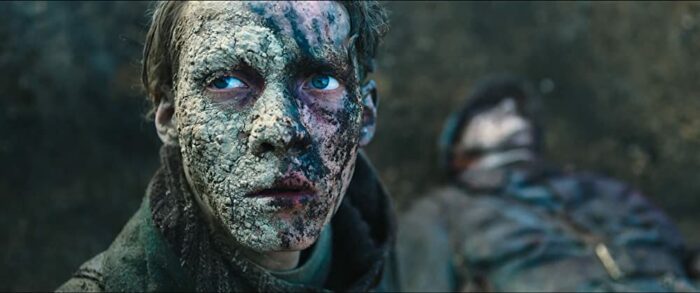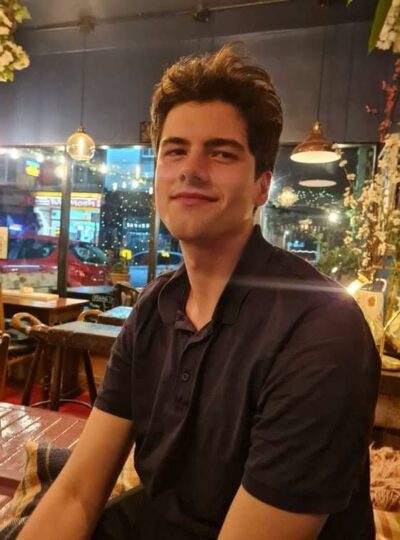Netflix has become quite the force to reckon with in the last few years when it comes to Awards campaigns and they went into 2022 with quite a few big hitters lined up. However, as prestigious ships like Blonde, Bardo: A False Chronicle of a Handful of Truths and White Noise all failed to come in (more or less, Blonde and Bardo still scored a couple of nominations, despite the derision they both elicited), the real sleeper success of the 2022-23 awards season emerged in the form of Edward Berger’s adaptation of Erich Maria Remarque’s 1929 novel and remake of its subsequent film adaptation by Lewis Milestone. The only non-English language film to have broken the glass ceiling separating Best International Feature and Best Picture, All Quiet on the Western Front is more or less guaranteed to win the former category and perhaps others of the nine categories where it has earned nominations.
Penned and published while the war was still alive in the public consciousness, yet before the world once again descended into an even larger conflict of a very different character, Remarque’s All Quiet on the Western Front instilled a firsthand picture of the war, as violent, anguished, and above all, fruitless. It’s a narrative that’s seen some erosion in recent years, where, in the context of the war’s centenary, it has been subjected to politically motivated revisionism, adorning the war dead with haloes and mischaracterizing their sacrifice as noble and just. The anniversary of the Armistice has become less a tragic reminder of the folly and abhorrent wastefulness of human lives our national leaders undertook, but as a crass and ungodly bastion of nationalist pride.
This narrative is reflected in recent depictions of the war, through the technologically remarkable but ideologically corrupt depictions of They Shall Not Grow Old or 1917, films which celebrate the bravery of the soldier, lamp-shading the motives of the war’s mongers and the violence enacted at their behest. In such a context, a remake of All Quiet on the Western Front comes as a much-needed reality check, with Edward Berger’s film matching the polished spectacle of these films, but rebuking their naivety with a less nauseatingly romantic perspective.
However, some have indeed criticized Berger’s film in turn, arguing that in replicating the savage beauty and violence of a Hollywood epic, it risks lionizing the same brutality it sets out to condemn. I tend to agree, that as a depiction of the war’s inhumanity and monstrous pointlessness, it does leave something to be desired and it’s certainly not savagery. The film’s scenes of battle are perhaps mundane in their formal presentation, but their content is intensity itself, with Berger’s vision being one of the most unrelentingly cruel and base depictions this particular war has yet seen. Men crush each other beneath tank tracks, burn them alive as they beg for mercy, and puzzle over how they shall ever live with themselves afterwards. It certainly seems true that the filmmaker’s real interest lies in depicting these scenes of battle, and less so the characters of the men involved or the sociological processes corralling them to the slaughter.
The faults of All Quiet on the Western Front, such as they are, are mostly structural and narratival. The film begins with a prologue throwing us into the middle of one of its most intense bouts, climaxing with our temporary protagonist bludgeoning his opponent to death with a short-handled shovel. This structuring sacrifices the suture with the protagonist Paul Baumer (Felix Kammerer), whom we meet later, to replicate a thematic beat from the original, wherein we see a dead soldier’s uniform recycled and passed off to an equally doomed new recruit. This moment could easily have come later or might well have had a subtler resonance had we been allowed to see this scene without the heavy-handed dramatic irony. As it is, we’re given the advantage of our young hero from the start and the more than two-hour long film has little in the way of dynamics or progression, with us detached from his journey of disillusionment early on.

On this journey, we follow Paul and his home-town comrades as they enlist, having been hyped up on nationalist military rhetoric by their schoolteacher—in a scene removed until after they’ve all already decided to enlist, another odd change that seems to exist purely for the sake of doing something different. We then accompany them to the front, which wastes no time shattering their naïve notions of the dignity and romance of warfare. We then jump forward in time to the final days of the war, with Paul and his dwindling group of friends’ efforts to survive playing out in tandem with Matthias Ertzberger’s (Daniel Bruhl) pains in negotiating a ceasefire, and more lenient terms for his defeated nation. Much of his dialogue comes off as artless foreshadowing of the nationalist resentment that France’s crippling demands sowed after Germany’s surrender, and of what that resentment helped incubate.
It would be a struggle to argue that this broader canvas particularly aids the film or its story. The merits of All Quiet on the Western Front lie in the ground-level, granular nature of its perspective. Adding a view on the conflict from those in command—not just Ertzberger, but also the ignorant saber-rattling monster General Friedrichs (Devid Striesow)—does little to enlighten or deepen this perspective, telling us little we don’t already know, while undermining the film’s already flimsy concision, pace and structure (none of which are particular strengths of any version of the story, it’s a very picaresque and episodic narrative). The film does make other tweaks to the events of the story here and there, though the story’s most haunting and unforgettable moment is preserved virtually unaltered, as Paul finds himself alone with a rival soldier and too late, their respective humanities resurface in a heartbreaking oasis of compassion amidst an endless desert of uniform carnage. It’s the best scene in any version of the story, and here’s it’s granted an impressionist aspect of realism, as one half of Paul’s face is completely caked in dried mud throughout, a visual embodiment of his jeopardized humanity.

Ultimately, despite their differing perspectives and objectives, the film’s greatest strengths are the same as 1917’s: its dark, oppressive form of beauty, and the score, built by pianist Volker Bertelmann upon a three-bass-note motif that becomes synonymous with the indifferent machinery of battle and the very essence of dread. Death is in those notes and they’re cheap but effective, and they alone probably earned Bertelmann his Oscar nomination. The likewise nominated cinematography of James Friend is similarly visually impressive, without having much identity, containing fragments of the wide angles Terence Malick used to such uneven success in A Hidden Life and The Thin Red Line, to convey the natural beauty we human despoil with our industrialize hate, and the low, static wide shots of Come and See, capturing the bleak, forbidding and sublime beauty at the battlefield’s fringes. And yes, there are long tracking shots a la 1917, following our broken hero as he staggers from one horror to the next, across that infamous muddy plain of death.
As with George MacKay in that film, Felix Kammerer is left to provide the nine-lived kernel of personhood around which the chaos of war swirls, and arguably does an even better job than MacKay did, given the deficiencies in the film’s script which offer little to work with. Another place the film echoes Come and See is in the vacant, angry desperation in Kammerer’s eyes. Albrecht Schuch is excellent too as his stoic comrade Kat, and their scenes together give us as much character as we ever get to chew on. Though the Academy are falling over themselves to nominate this film in as many categories as possible, it’s omission from the acting categories suggests they still have a ways to go when it comes to appreciating performances in another language.
There’s undeniable strengths to Berger’s version of All Quiet on the Western Front, a vision that sacrifices delicacy, tact and humanism in favor of sheer visceral brutality and epic scope. By the final act, it truly feels as if Paul and his fellows have descended into some uncharted circle of hell, an impression I’d have loved for the film to have followed through on (the ending is a bit of a cop-out). Sadly though, for all its technical bravura, it’s not an especially imaginative or novel exploration of its themes or its tropes, and it feels like a film that makes its voice heard, despite being a little unsure of quite what it wishes to add to the conversation.




